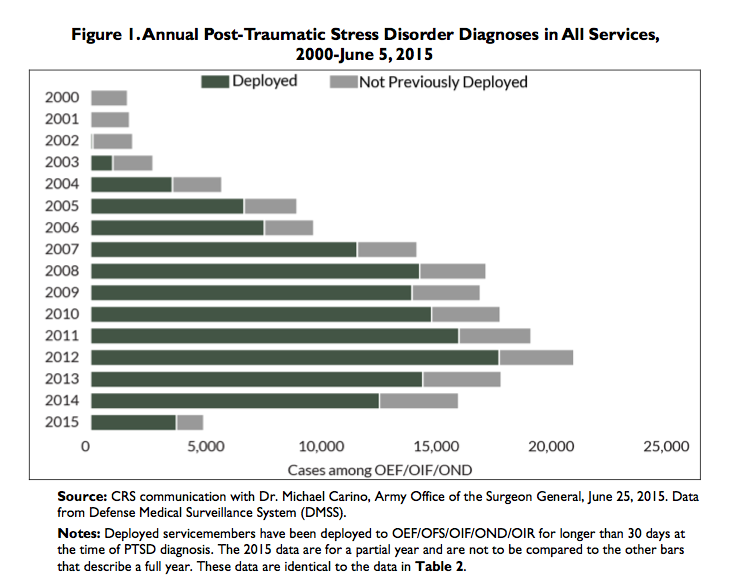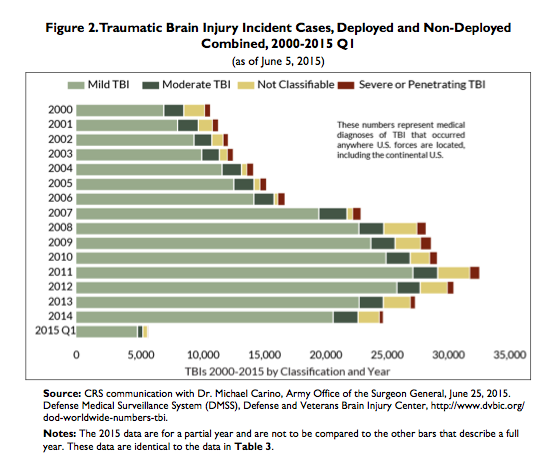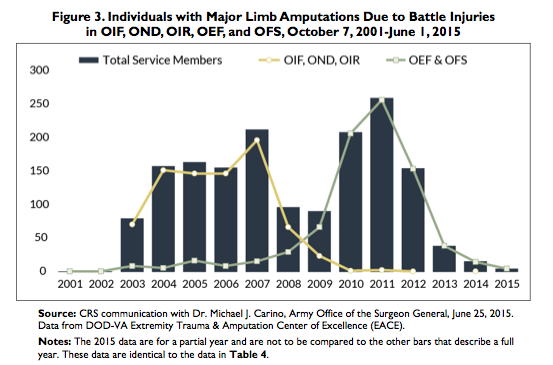US Military Casualties In Operations Since 2001: 6,855 Killed, 52,351 Wounded In Action – Analysis
By CRS
By Hannah Fischer*
Operation Enduring Freedom (OEF) began on October 7, 2001, and was primarily conducted in Afghanistan. On December 28, 2014, President Obama announced that OEF had ended.1 A “follow-on mission,” Operation Freedom’s Sentinel (OFS), was started on January 1, 2015, to “continue training, advising, and assisting Afghan security forces.”2
Operation Iraqi Freedom (OIF) began on March 19, 2003, and was primarily conducted in Iraq. On August 31, 2010, President Obama announced that OIF had ended.3 A transitional force of U.S. troops remained in Iraq under Operation New Dawn (OND), which ended on December 15, 2011.4 Several thousand U.S. civilian personnel, contract personnel, and a limited number of U.S. military personnel remain in Iraq carrying out U.S. government business and cooperative programs under the auspices of agreements with the Iraqi government. On October 15, 2014, U.S. Central Command designated new military operations in Iraq and Syria against the Islamic State of Iraq and the Levant as Operation Inherent Resolve (OIR).5
Daily updates of total U.S. military and civilian casualties in OIF, OEF, OND, OIR, and OFS can be found at the Department of Defense’s (DOD’s) website, at http://www.defense.gov/news/ casualty.pdf. Table 1 gives the overall casualties in OIF, OND, and OEF.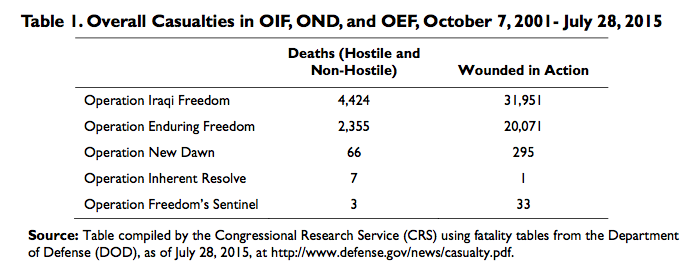
Post-Traumatic Stress Disorder
The U.S. Army Office of the Surgeon General (OSG), using the Defense Medical Surveillance System (DMSS), provided data on the incidence of post-traumatic stress disorder (PTSD) cases. According to Dr. Michael Carino of the OSG, a case of PTSD is defined as an individual with two or more outpatient visits or one or more hospitalizations during which PTSD was diagnosed.
The threshold of two or more outpatient visits is used in the DMSS to increase the likelihood that the individual has, or had, clinically diagnosable PTSD. A single visit on record commonly reflects a servicemember who was evaluated for possible PTSD, but did not actually meet the criteria for clinical diagnosis.
In this data set, an incident of PTSD among deployed servicemembers is defined as occurring when a deployed servicemember was diagnosed with PTSD at least 30 days after being deployed.6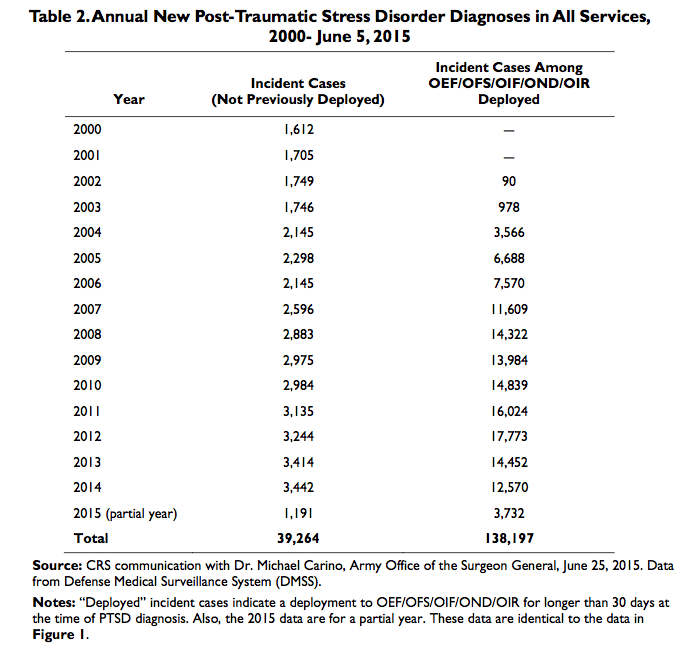
 Traumatic Brain Injury
Traumatic Brain Injury
Many statistics on traumatic brain injury (TBI) are available to the public, at the Defense and Veterans Brain Injury Center, at http://dvbic.dcoe.mil/dod-worldwide-numbers-tbi. Unlike PTSD numbers, which are segmented by those deployed and those not previously deployed, TBI numbers represent medical diagnoses of TBI that occurred anywhere U.S. forces are located, including the continental United States.7
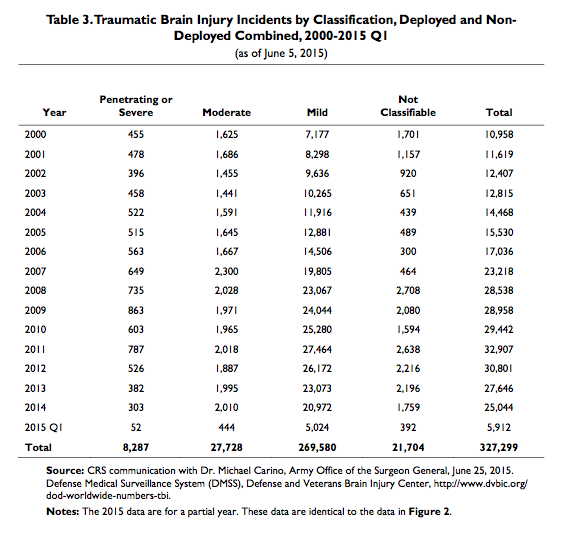
Major Limb Amputations8
Table 4 shows the number of individuals with battle-injury major limb amputations for OEF, OFS, OIF, OND, and OIR. A major limb amputation includes the loss of one or more limbs, the loss of one or more partial limbs, or the loss of one or more full or partial hand or foot. The total number of individuals with major limb amputations as of June 1, 2015, is 1,645.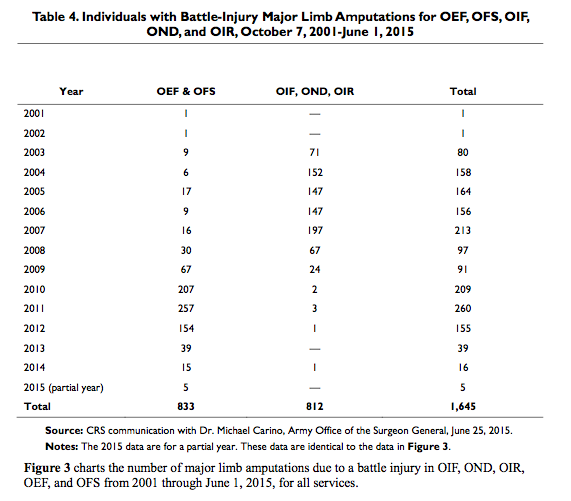
Other Available Data: Demographic Data on Casualties
DOD provides data on the demographics of servicemembers who have died or been wounded in action in OIF, OND, and OEF through the Defense Casualty Analysis System at https://www.dmdc.osd.mil/dcas/pages/casualties.xhtml. To find this information, select a conflict and select between “deaths” or “wounded in action,” and then select from the demographic categories, including gender, age, race, and ethnicity. Similar data have not yet been publically released for OEF and OIR.
About the author:
*Hannah Fischer, Information Research Specialist [email protected]
Source:
Congressional Research Service
Notes:
1 The White House, Office of the Press Secretary, “Statement by the President on the End of the Combat Mission in Afghanistan,” December 28, 2014, at https://www.whitehouse.gov/the-press-office/2014/12/28/statement-president- end-combat-mission-afghanistan.
2 Department of Defense, “Statement by Secretary of Defense Chuck Hagel on Operation Enduring Freedom and Operation Freedom’s Sentinel,” December 28, 2014, at http://www.defense.gov/releases/release.aspx?releaseid=17091.
3 The White House, Office of the Press Secretary, “Remarks by the President in Address to the Nation on the End of Combat Operations in Iraq,” August 31, 2010, at http://www.whitehouse.gov/the-press-office/2010/08/31/remarks- president-address-nation-end-combat-operations-iraq.
4 Remarks by the President and First Lady on the End of the War in Iraq, December 14, 2011, at http://www.whitehouse.gov/the-press-office/2011/12/14/remarks-president-and-first-lady-end-war-iraq.
5 U.S. Department of Defense, “Centcom Designates Ops Against ISIL as ‘Inherent Resolve’,” October 15, 2014, at http://www.defense.gov/news/newsarticle.aspx?id=123422&source=GovDelivery.
6 CRS communication with Department of Defense, Office of the Secretary of Defense liaison, September 21, 2010.
7 Defense and Veterans Brain Injury Center, at http://www.dvbic.org/dod-worldwide-numbers-tbi. The DOD categorizes TBI cases as mild, moderate, severe, or penetrating. Mild TBI is characterized by a confused or disoriented state lasting less than 24 hours; loss of consciousness for up to 30 minutes; memory loss lasting less than 24 hours; and structural brain imaging that yields normal results. Moderate TBI is characterized by a confused or disoriented state that lasts more than 24 hours; loss of consciousness for more than 30 minutes, but less than 24 hours; memory loss lasting greater than 24 hours but less than seven days; and structural brain imaging yielding normal or abnormal results. Severe TBI is characterized by a confused or disoriented state that lasts more than 24 hours; loss of consciousness for more than 24 hours; memory loss for more than seven days; and structural brain imaging yielding normal or abnormal results. A penetrating TBI, or open head injury, is a head injury in which the dura mater, the outer layer of the system of membranes that envelops the central nervous system, is penetrated. Penetrating injuries can be caused by high- velocity projectiles or objects of lower velocity, such as knives, or bone fragments from a skull fracture that are driven into the brain. “Not Classifiable” indicates additional incident information is required prior to TBI categorization.
8 A previous update of this report included major and minor limb amputations. However, statistics on minor limb amputations were not available for this update.


